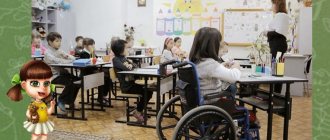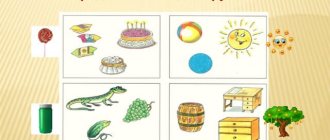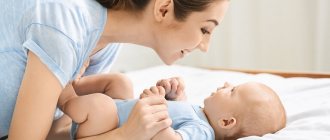Parent meeting “Age characteristics of young children”
Ostrovskaya Vera Arkadyevna,
MAUDO teacher
“Child Development Center – Kindergarten”,
Yalutorovsk
Goal: to deepen parents’ knowledge about the mental and physical characteristics of children in their third year of life.
Progress of the meeting
1. Greeting.
Hello, dear parents! We are glad that you found the time and desire to chat, talk about children, learn something new and interesting. First of all, let's get acquainted. I suggest everyone write their name on a piece of paper and attach it to their clothes, and you need to introduce yourself in this way: say your name and an epithet word that begins with the same letter, for example, Vera - faithful, etc.
2. Introduction to the topic of the meeting.
Your children have grown up and entered kindergarten. what has your child become, what has changed in him? Balloons will help you tell the story. Pass them along to music. At the end of the music, pop the balloon, take out the note and tell us how this feature manifests itself in your child.
(speech development, relationships with adults, Personality formation (self), play, memory)
3. Discussion and addition of parents’ statements.
Speech development - at this age the child learns to understand speech. It’s not for nothing that he loves to listen to adults talk. He likes to listen to stories, fairy tales, poems, nursery rhymes - this means that the child begins to explore the world with the help of language. An interesting fact: at 2-3 years old, a child’s vocabulary ranges from 300 to 1500 words. By the age of three, the child masters all cases and can construct complex sentences using prepositions.
The game is an objective game, because the object of knowledge is objects, their internal structure. The way of knowing is to disassemble, break. At this age, the child performs various actions with toys that he observed in adults, thus imitation games appear. Play at this age is often individual, and the child’s peers are of little interest to him. Only in the fourth year do children begin to show interest in a peer as a play partner.
Relationships with adults - an adult is interesting as a source of information, protection and affection. Therefore, a long separation is perceived painfully. But despite this, they manifest a need for independence, and personality formation occurs.
The formation of personality (I) is associated with the formation of self-awareness: he recognizes himself in the mirror, knows and responds to his name, realizes his place among his peers. Three- and four-year-olds begin to compare themselves with other people, their self-esteem and desire to meet the requirements of adults develop.
Memory development – involuntary memory, i.e. The child cannot specifically learn or remember any information. Only with repeated repetition does he form a memory. 75% of children's recall occurs at the age of 3-4 years, i.e. By the end of early childhood, long-term memory and its basic mechanisms are formed.
Conclusion: thus, personality formation, play, development of speech, memory, relationships with adults are the main directions in the development of children.
3. Exercises
Your child has changed, and your relationship with him must change too. I suggest you divide into groups according to the seasons. (cards “Winter”, “Spring”, “Summer”, “Autumn”). In groups, create your own recipe for the desired relationship between parents and child.
A recipe for desirable communication between parents and children
Take P_________, add P___________ to it, mix with a certain amount of P__________ L__________ and D__________, add your own O_____________, seasoned with loving maternal and paternal A_____________.
Now let's see what you got (recipes are read out).
Each recipe is unique and has the right to exist. You understand your position correctly. But I want to offer you one more recipe, maybe someone will take it into use.
Meaning of words:
Acceptance is an understanding of such love when a child understands that he is loved no matter what.
Recognition is the preservation of a child’s self-esteem and confidence.
Parental love - if you sow love and affection in childhood, you nurture and cherish it in adolescence, you will reap it in full in old age.
- remember how you affectionately call your child.
Conclusion: these gentle words are like stroking for a child and for a person in general. Psychologists say that 98% of children have never received physical support. To develop self-confidence, a child needs 3 strokes a day, for confidence in the family - 6 strokes, for confidence in society - 9 strokes, to be a leader - 12 strokes.
Availability means being ready to put aside your own affairs at any moment and communicate with your child.
Responsibility is acquired throughout life. Conditions for development: the presence of certain daily responsibilities; do not take responsibility for the child’s actions; the ability to say “No” to a child.
Conditions for the development of responsibility are the presence of certain daily responsibilities, not taking responsibility for the actions of children, the ability to tell the child: “No”
Authority is gained through years of dedicated parental work.
No matter what changes happen to the child, this recipe will always help us.
4. Tasks of work for the 2008-2009 academic year.
Speech development - by the end of the year, the child should name pieces of furniture and clothing. Toys, fruits, distinguish between wild and domestic animals. For the full development of speech, the group has play areas with various animal toys, a puppet theater, and a finger theater. The group learns rhymes, nursery rhymes, finger games. For the same purpose, the “White-sided Magpie” circle is held, the goal of which is to develop the child’s speech through oral folk art.
Artistic activity - hold a pencil correctly, make strokes, straight lines, know the primary colors (yellow, red, blue, green, black, white).
Modeling - roll plasticine in circular movements and straight movements.
Construction - distinguish between types of building materials - bricks, cubes, plates.
Development of self-service and cognitive skills - undressing and dressing independently, unbuttoning and fastening buttons, holding a spoon correctly, knowing the words of greeting and farewell, showing empathy for peers.
Physical education - we teach children to jump, run, respond to signals, and perform movements according to the text.
5. Exercises.
Game “Say a Word” (in a circle, parents pull out a piece of paper with an unfinished phrase and complete it)
- Memory in a 2-3 year old child... involuntary
- Game of young children... object-based
- At 2-3 years old, children’s vocabulary is ... 300-1500 words
— During modeling, a child learns to roll plasticine...in circular and...straight movements
— During construction, the child gets acquainted with the building material... the cube. brick, plate.
— By the end of the year, the child should name objects... furniture, clothes, dishes, toys, fruits, vegetables.
6. Summary. Reflection .
Game "Telegram".
Author: Ostrovskaya Vera Arkadyevna
We invite teachers of preschool education in the Tyumen region, Yamal-Nenets Autonomous Okrug and Khanty-Mansi Autonomous Okrug-Yugra to publish their teaching materials: - Pedagogical experience, original programs, teaching aids, presentations for classes, electronic games; — Personally developed notes and scenarios of educational activities, projects, master classes (including videos), forms of work with families and teachers.
Why is it profitable to publish with us?
1. “Kindergartens of the Tyumen Region” is an officially registered specialized media outlet at the federal level. 2. The activities of the editorial office are supported by the Department of Education and Science of the Tyumen Region 3. We issue a “Certificate of Publication” in the media. 4. The document has a unique number, is entered in the register, has the original seal of the editorial office of the online publication and signature. 5. “Certificate of publication” in the media is sent to the author in both paper and electronic versions.
Details >>>
Sample “Certificate of publication of author’s methodological material in the media.”pdf
Share
Summary of the first parent meeting in the junior group of the preschool educational institution
The first parent meeting in the junior group
ADAPTATION PERIOD” Purpose: - To introduce parents to each other, to teach them partnerships with each other and teachers - To give parents an idea of the physical, mental, mental development of children 3-4 years old. Agenda: 1. Introducing parents to each other 2. Results of the adaptation period 3. Speech by the head of the MBDOU 4. Miscellaneous 1. INTRODUCTION TO THE MEETING AGENDA Good evening.
We are glad to see you at our first meeting. Today we have our first parent meeting, at which we will meet, get to know each other better, we will tell you about what we have already learned during the period of adaptation to kindergarten and what we still have to learn. After that, you and I will choose a parent committee and take care of New Year's gifts for our children. 2. STROKE:
So, you brought your children to kindergarten and we have one common goal, to make their stay here comfortable, safe, interesting, exciting, educational, etc. During the child’s stay in kindergarten, we (children, teachers, parents ) make a triangle.
At the head of the triangle, of course, is the child. What do you think will happen to a tripod stool if one leg breaks (falls) That’s right, it will fall! Remember Krylov’s fable “The Swan, the Crayfish and the Pike” where it says: “When there is no agreement among the comrades, their business will not go well, what will come out of him is nothing but torment! “Therefore, you and I need to join forces to ensure that children are interested and comfortable in kindergarten, and here it is very important to have mutual understanding and support. You and I will live alone for 5 years, we hope to be a friendly family. But first you need to get to know each other better. I will ask you to stand in a circle. -Children love to play “Magic Wand”. Now we will try to plunge into childhood and also play. Rules of the game: The one who holds the magic wand calls himself the way he would like others to call him. -So you’ve met, and now tell me, how many Oksanas are there in our circle? Tatiana? Etc. -Now let's get to know each other better. In the first circle stand the parents who have one child, in the second the parents of two children, in the third, respectively, the parents of three or more children. -Now let’s see who has more boys or girls in our group? The first group consists of parents of girls, and the second group of boys. -And now we will ask everyone to stand in a circle, take a ball and each parent, picking up the ball, will say their name (so in a circle) Now we wish that we all live together so unitedly and amicably for all 5 years. We want you to walk like this for five years, hand in hand, and become a truly friendly big family. 3. And now we will ask you to sit down and we will tell you what we have already learned. And we learned a lot. Our group has 11 classes per week. These are: drawing, modeling, music - for this lesson we go up to the music room, the rest of the classes are held in a group, physical education (in our garden there is a gym and we work there with an instructor), familiarization with the environment, artistic reading, speech development We see particularly striking achievements in this area. All classes are held in a playful way. Children have become more sociable and are beginning to learn to play together and share toys. All children know where their cubicle, towel, potty, and crib are located. We learned some rules of behavior in the group. They know that after washing their hands they need to squeeze out the water and only then go to their towel. Almost all children eat on their own, with a little help from adults. They undress. Learning to dress. We learned how to carry out basic tasks and put away toys. As you can see, we have learned a lot, but we have even more to learn and, most importantly, teach children self-care. And in this process you must take an active part. It often happens that a child in kindergarten eats, undresses and partially dresses on his own, but after some time at home he comes to kindergarten and we again teach him to eat, dress, etc. And when communicating with you, it turns out that at home you did everything for because it’s faster, more convenient, neater, etc. Give children the opportunity to be independent, of course, in accordance with their age. 4. MISCELLANEOUS - Selection of the parent committee - Labeling of clothes - Gratitude for help in cleaning up leaves - Birthdays - New Year Memo for parents Dear parents! In order for your child to more easily adapt to our kindergarten, to get used to the teachers, new living conditions, and daily routine, we need your support and cooperation. To get started, try to follow a few simple rules: - Bring your child to kindergarten at the same time (from 7.00 to 8.30) - Address the teachers by their first name and patronymic. — at home, watch how your child washes his hands (rolling up his sleeves, not splashing water, using soap correctly, not getting his clothes wet, wiping himself dry with a towel.); watch how he dresses and undresses (let him do it himself, in a certain sequence, fold clothes, hang them on a chair, unbutton them and fasten buttons); drink from a cup, eat, chew food well with your mouth closed, use a spoon or napkin correctly; learn to put toys away independently and in a certain place. — A calm, attentive attitude towards the child at home during the adaptation period is the key to success! — Put your child to bed on time in the evening. — Make sure that the child’s clothes are not too large or do not restrict his movements. In properly selected clothes, the child moves freely and gets tired less. Ties and fasteners should be located so that the child can serve himself. Shoes should be light, warm, exactly match the size of the child’s feet, and easy to take off and put on. A child needs a handkerchief both indoors and during walks. — To avoid accidents, check the contents of your child’s clothing pockets every day for dangerous objects. It is prohibited to bring sharp, glass objects, as well as small beads, buttons, chewing gum, and tablets to the kindergarten. — It is not recommended to wear expensive jewelry on a child. We remind you that in case of loss, the teacher does not bear financial responsibility for them. — Do not discuss your concerns, complaints and worries about kindergarten in front of your child at home, but be sure to share them with the teachers. — The main thing for successful adaptation is your positive attitude, adherence to the daily routine and recommendations of teachers. It is necessary to properly guide the actions of children; before expecting independence from a child, he must be taught the actions necessary in the process of dressing, washing, and eating. We hope for fruitful cooperation!
We recommend watching:
Game workshop for parents of the nursery group of the kindergarten. Parent meeting in the first junior group. Abstract: Adaptation of a child to a preschool educational institution. Tips for parents Parent meeting in the nursery group. Abstract
Similar articles:
Consultation for parents “Your child is going to kindergarten”



